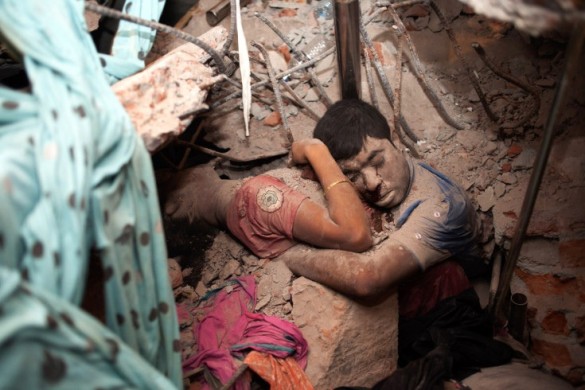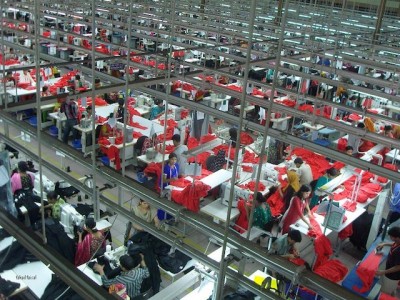
April 25, 2013. Two victims amid the rubble of a garment factory building collapse in Savar, near Dhaka, Bangladesh. Photo: asitimes
“Retailers are our friends, and, of course, the factory workers are our partners,” says Riaz Bin Mahmud, the vice-president of the Bangladesh Garment Manufacturers and Exporters Association (BGMEA).
If that’s the case, then most international retailers—who Mahmud believes are accountable for the working conditions of their employees—have been acting less than amenably since the collapse of Rana Plaza in April, which claimed over a thousand lives.
There have since been very few labour reforms or developments in the garment industry to give any cause for optimism.
Primark, Tommy Hilfiger, Calvin Klein, Zara and Tesco are among the companies that have signed the accord on Fire and Building Safety established by international labour rights groups. This pact aims to compel retailers to pay up to $500,000 a year for strict public inspections and promises to blacklist any factories unwilling to comply.
GAP, JC Penny, the Arcadia group and Wal-Mart, are on the list of retailers who failed to meet the accord’s deadline, set by not-for-profit organisations and labour leaders.
The refusal of these international companies to commit to workers’ safety, together with the endemic corruption of factory owners and government officials, heralds a dangerous and uncertain future for the workers of the world’s leading industries.
Last month, Walmart, in response to the disaster it had initially been reluctant to be held accountable for, issued a statement declaring it had already organised its own safety plan to improve working conditions in its factories.
As part of its initiative, the US retail corporation would fund inspections at its 279 factories in Bangladesh, and publish the results on its website by June 1, Bloomberg reported. Where fire and building safety issues are found, Wal-Mart Stores Inc indicated it would require factory owners to make necessary renovations or risk being debarred from its list of authorised manufacturers. The undertaking was put forward as a commitment, but is different from the legally-binding pact meant to prevent disasters like the Rana Plaza collapse.
http://youtu.be/f29fwcdOAWA
But as of the first week of June, there is yet no evidence of the company’s solo effort. To date, there have been no announcements of “inspection results” on its official website.
“The bottom line is there’s no accountability. It’s still a Wal-Mart-run and -controlled program in which Wal-Mart calls every shot,” Scott Nova, the executive director of the Worker Rights Consortium in Washington, told Bloomberg.
In another statement, reported by The Wall Street Journal, Nova said: “Wal-Mart’s ruthless drive for low production costs regardless of consequences of workers has been the single biggest contributor to working conditions in Bangladesh.”
Like Nova, many believe the move is merely the company’s public relations effort to soothe public qualms about ethical buying.
“When you leave it in the companies’ hands, the companies have a profit-driven motive to do as little as possible. There needs to be a much greater level of scrutiny and transparency among the providers, the manufacturers and the retailers,” said Rohan Wenn, Communications Director of independent Australian advocacy group GetUp!.
“Big companies can make it look like they aren’t exploiting the developing world, even if they are.”
The apparel sector earns nearly $20 billion annually, which amounts to approximately 80 per cent of the country’s total export earnings. Numerous Western brands, attracted by cheap labor, turn to Asia to manufacture enormous volumes of products to offer to consumers at low prices.
With four million workers, Bangladesh is the second-biggest garment maker in the world and the third-biggest exporter of clothes, after China and Italy. Despite being forced to face chronically unsafe working conditions and receiving barely subsistence wages, the women from poor rural backgrounds – who comprise 85 per cent of the industry’s labour force according to BGMEA – endure these conditions to earn a living. The average Bangladeshi factory worker in the garment industry makes between 10 and 30 cents an hour and 3000 takas a month ($38), according to the Associated Press.
Since 2005, at least 1,800 garment workers have been killed in factory fires and building collapses in Bangladesh, according to research by the advocacy group International Labor Rights Forum. In September 2012, two fires ravaged textile factories in Karachi and Lahore, Pakistan on the same day. And three weeks after the collapse of Rana Plaza, the ceiling of a shoe factory in Cambodia caved in, killing two workers.
This long string of tragedies leading to the collapse of the Plaza, and the ones that will follow if proper measures aren’t taken to improve safety standards in factories, focuses global attention on the indifference of international retailers to the plight of their workers.
Several companies do not subscribe to the compliance programs whose parameters are set by the buyers and the government. In these programs, factory inspections are conducted unannounced to ensure that compliance standards have not been compromised.
Many also reject accountability and decline to compensate victims of factory disasters. In the wake of last year’s factory fire in the Ashulia district of Bangladesh’s capital city, retailers Walmart and Sears Holdings refused to pay damages to those who were injured and to relatives of victims of the disaster.
In the latest Bangladeshi industrial tragedy, most companies claimed ignorance of working conditions on the ground and point fingers at building owners and local government officials.
Although the Bangladeshi government has eased its policies on trade unions, allowing workers to form unions without prior permission from factory owners, and established a minimum wage board, workers’ safety cannot be guaranteed when “profit before people” is the priority behind most corporate decisions.
Retail consultant Burt Flickinger told CNN, “Apparel retailers don’t have enough of a corporate conscience. They feel guilty about what’s happened, but they’re concerned about their competition, cash flow and raising dividends for stockholders.”
It’s a severely unbalanced relationship between retailers and the countries that manufacture their products where the big corporations have all the power and the small manufacturers don’t, Wenn said.
“They know that if they step out of line, Nike or Wal-Mart can rip out the contracts from underneath them and they’ll be left with nothing.”
Advocacy group Open Democracy advices global brands to not pull out of Bangladesh because of the high risks of manufacturing there and the potential for a social media backlash. Instead, they advocate staying and using their economic leverage to improve the working conditions of the labour force.
But chances are that international retailers will continue to order extreme quantities from Asian factories regardless of the dangers; the low price tag attached to the high quality craftsmanship of apparel manufactured in Bangladesh is too enticing for companies to ignore.
“While Western retailers have worked a lot for the development of the country, at the same time, some of our buyers squeeze their prices to the last end,” said BGMEA Vice-President Mahmud. “We need to produce on time, people need to get paid on time… and this has a cost.”
Wenn recommends the establishment of a tax on foreign corporations that manufacture their products in Bangladesh.
“That money could be used to better scrutinise the factories to ensure that they are safe workplaces and that the labour laws are being followed,” he said.
“If people were given a choice between cruel products and ethical products, they will choose the slightly more expensive products because they know it will reduce the level of cruelty involved in the process.”
But while retailers are inextricably linked to the disaster, so are the consumers who buy the massive quantity of products churned out by factories in developing countries. Consumer habits, shaped by years of ‘fast fashion’, are as much to blame as retailers’ demand for extraordinary quantities of products to be delivered to stores on time.
“It’s great to be able to get cheap clothes and cheap goods,” said Wenn. “But if they’re coming at a human cost, that’s not acceptable.”



